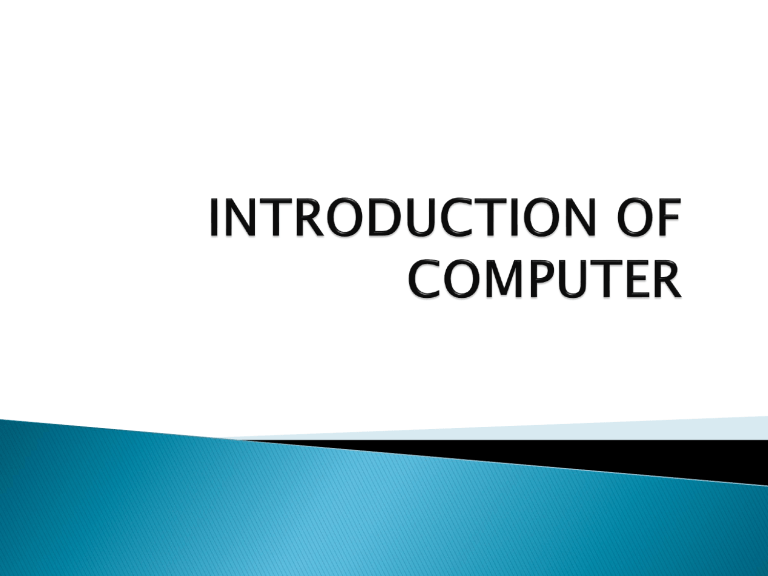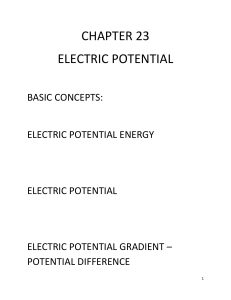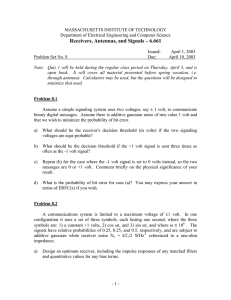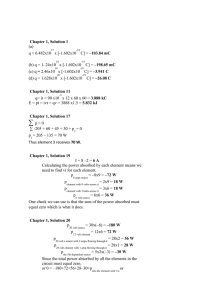
An electronic device that stores, retrieves, and processes data or which manipulates data according to a list of instructions and which is composed of hardware and software. Computers are popular because of following characteristics: Speed: Computer can perform a task much faster than done manually. Accuracy: Computer gives accurate results compared to task done manually. Storage: Computer stores the information in its main memory and the same can be retrieved based on the requirement. Multitasking: Computer performs multiple tasks simultaneously. For example, one can use the computer to take a printout of an inventory report and at the same time can use it to draft letters. Communication: Computer can be used to exchange information between two or more computers. Internet is the best example of this. Business Area Entertainment Area Education Area Medicinal Area Finance Area Bit Byte Kilobyte (KB) Megabyte (MB) Gigabyte (GB) Terabyte(T B) 8 Bits = 1 Byte 1024 Bytes = 1 Kilo Byte(KB) 1024 KB = 1 Mega Byte(MB) 1024 MB = 1 Giga Byte (GB) 1024 GB = 1 Tera Byte ( TB) 1024 TB = 1 Peta Byte ( PB) 1024 PB = 1 Exa Byte ( EB ) 1024 EB = 1 Zetta Byte ( ZB) 1024 ZB = 1 Yotta Byte ( YB) 5 0 = Off 1 = On 6 7 Input- Computer store the data in its input devices like keyboard and mouse by the users. Process- Computer process the Data in its processing unit like CPU Output- Computer show the data in its output screen(Monitor) Storage- computer stores the data in its storage device(HDD) INPUT CPU STORAGE OUTPUT The physical components of a computer are called computer hardware. Devices connected internal are called the primary components and connected external are called the peripherals. Some of the devices that are attach internally are called Primary Components. i. Motherboard: It is a main circuit board that content processor slot, chipset, front side bus(FSB), RAM’s slots, PCI, Internal Components, ports, keyboard and mouse connect USB port, display connector, speaker, microphone etc. ii. Hard Disk: It is a magnetic memory device used for permanent storage. iii. Optical Drive: Data used to read and write data from the optical media is called CD/DVD ROM etc. the CD ROM content 700 MB and DVD content 1.5 GB iv. SMPS(Switch Mode Power Supply): It convert the AC input into DC output. v. Floppy Disk Drive: It is used to read drive floppy disk. The devices that are attached externally to the computer are called peripherals 1. Keyboard: It is a input device. It consist rectangular or near rectangular buttons called keys. The standard keyboard consist of 101 to 104 keys. 2. Mouse: It is a Pointing device use to move a graphics pointer on the screen this graphics pointer is called cursor. Using mouse you can give commands, draw images and perform other input task. 3. Scanner: It is a optical device that analysis images, printing text, hand writing and digital images. 4. Joystick: It is commonly used for controlling player movement. 5. Microphone: It is used for recording audio in a computer. A sound cart converts and analog sound signal to digital form. 6. Digital Camera: It is a input device used for capture and storing still images. You can convert a digital camera to a computer and transfer the images from others. Input Devices Output Devices Processor Primary Memory(Main Memory) Secondary Storage Devices Internal Components Software Mouse Keyboard Scanner Digital Camera Web Camera Joysticks Trackball Touch Pad/Screen Light Pen Bar Code Reader Microphone Graphics Tablets Magnetic Ink Character Reader Optical Mask Reader Magnetic Card Read Biometric Devices Bluetooth Monitor Printer Projector Plotter speaker It is the main unit inside the computer this unit is responsible for all event inside the computer. It control all internal and external devices to perform arithmetical and logical operations. The CPU is a device that interprets and execute instructions. RAM(Random Access Memory) ROM(Read Only Memory) Hard Disk(Local Disk) Optical Drive(CD Writer and DVD) Pen Drive Zip Drive Floppy Disk Memory Cards External Hard Drive The Mother Board Expansion Slots CMOS Battery Cooling Fan Network Card Graphics card Power Supply Unit Memory Slots Software is a program that enables a computer to perform a specific task, as opposed to the physical components of the system. Without software, computers would be useless. This includes application software such as a word processor, which enables a user to perform a task, and system software such as an operating system, which enables other software to run properly. Computer software has to be "loaded" into the computer's storage (such as a hard drive, memory, or RAM). LOW LEVEL LANGUAGE HIGH LEVEL LANGUAGE In computer science, a lowlevel programming language is a programming language that provides little or no abstraction from a computer's instruction set architecture—commands or functions in the language map closely to processor instructions. Generally this refers to either machine code or assembly language. There is two type of low level languages:◦ Machine level language ◦ Assembly language These language instructions are directly execute by CPU. Machine language, the numeric codes for the operations that a particular computer can execute directly. The codes are strings of 0s and 1s, or Binary digits. Assembly language is one level above machine language. Assembly language programs are translated into machine language by a program called an assembler. It uses short codes for instructions and allows the programmer to introduce names for blocks of memory that hold data. A programming language such as C, FORTRAN, or Pascal that enables a programmer to write programs that are more or less independent of a particular type of computer. Such languages are considered high-level because they are closer to human languages and further from machine languages. The user friendly language. There are three basic kinds of computers. This is based on the hardware structure and the way physical quantities are represented in a computer. The following are the three types. ◦ Analog Computer ◦ Digital Computer ◦ Hybrid Computer Analog computers are used to process analog data. Analog data is of continuous nature and which is not discrete or separate. Such type of data includes temperature, pressure, speed weight, voltage, depth etc. These quantities are continuous and having an infinite variety of values. It measures continuous changes in some physical quantity e.g. The Speedometer of a car measures speed, the change of temperature is measured by a Thermometer, the weight is measured by Weights machine. 0 A Digital Computer, as its name implies, works with digits to represent numerals, letters or other special symbols. Digital Computers operate on inputs which are ONOFF type and its output is also in the form of ON-OFF signal. A digital computer can be used to process numeric. It can perform arithmetic operations like addition, subtraction, multiplication and division. The most common examples of digital computers are accounting machines and calculators. A hybrid is a combination of digital and analog computers. It combines the best features of both types of computers, i-e. It has the speed of analog computer and the memory and accuracy of digital computer. Hybrid computers are used mainly in specialized applications where both kinds of data need to be processed. Therefore, they help the user, to process both continuous and discrete data. Different types and sizes of computer are offering different services. The four basic types of computer. 1. Super Computer 2. Mainframe Computer 3. Mini Computer 4. Micro Computer A supercomputer is a computer with great speed and memory. This kind of computer can do jobs faster than any other computer of its generation. They are usually thousands of times faster than ordinary personal computers made at that time. These are specialized and task specific computers used by large organizations. These computers are used for research and exploration purposes. A mainframe computer is a very large computer capable of handling and processing very large amounts of data quickly. They are used by large institutions, such as government agencies and large corporations. It can also process and store large amount of data. Banks, insurance companies use mainframe computers to store data. Mini computers are used by small businesses and firms. These computers are not designed for a single user. Individual departments of a large company or organizations use mini computers for specific purposes. For example, a production department can use mini computers for monitoring certain production process. A microcomputer is a complete computer on a smaller scale and is generally a synonym for the more common term, personal computer. It is a computer with a central processing unit (CPU) as a microprocessor. Designed for individual use, a microcomputer is smaller than a mainframe or a minicomputer. Desktop computers, laptops, tablets and smartphone are all types of micro computer. First Generation Second Generation Third Generation Fourth Generation Fifth Generation 35 There are a number of third party anti virus products available. Most of these are better than the rather rudimentary products available within DOS and Windows, but of course you do have to pay for them! Many companies supply updated disks on a regular basis or allow you to receive updates through an electronic, on-line bulletin board. Advantages are :Vacuum tubes were the only electronic component available during those days. Vacuum tube technology made possible to make electronic digital computers. These computers could calculate data in millisecond. Disadvantages are :The computers were very large in size. They consumed a large amount of energy. They heated very soon due to thousands of vacuum tubes. They were not very reliable. Air conditioning was required. Constant maintenance was required. Non-portable. Costly commercial production. Limited commercial use. Very slow speed. Limited programming capabilities. Used machine language only. Used magnetic drums which provide very less data storage. Used punch cards for input. Not versatile and very faulty. Advantages are:Smaller in size as compared to the first generation computers. The 2nd generation Computers were more reliable Used less energy and were less heated. Wider commercial use Better portability as compared to the first generation computers. Better speed and could calculate data in microseconds Used faster peripherals like tape drives, magnetic disks, printer etc. Used Assembly language instead of Machine language. Accuracy improved. Disadvantages are :Cooling system was required Constant maintenance was required Commercial production was difficult Only used for specific purposes Costly and not versatile Punch cards were used for input. Advantages are :Smaller in size as compared to previous generations. More reliable. Used less energy Produced less heat as compared to the previous two generations of computers. Better speed and could calculate data in nanoseconds. Used fan for heat discharge to prevent damage. Maintenance cost was low because hardware failure is rare. Totally general purpose Could be used for high-level languages. Good storage Versatile to an extent Less expensive Better accuracy Commercial production increased. Used mouse and keyboard for input. Disadvantages are :Air conditioning was required. Highly sophisticated technology required for the manufacturing of IC chips. Advantages are:More powerful and reliable than previous generations. Small in size Fast processing power with less power consumption Fan for heat discharging and thus to keep cold. No air conditioning required. Totally general purpose Commercial production Less need of repair. Cheapest among all generations All types of High level languages can be used in this type of computers Disadvantages are:- The latest technology is required for manufacturing of Microprocessors. ADVANTAGE: It is very portable. Easy to use and maintenance. Not hit. Computers are popular in a number of applications because of its speed of operation, high storage capacity of media like hard disk, CD and so on, consistency and accuracy in computations and support to other electronic devices for engineering applications. A computer is an electronics device each requires electrical power for its functioning. The electrical power that is coming in your home is called Alternating current(AC) and the electrical power that the computer system require is called Direct current(DC). Ferro Resonant Power Supply Linear Power Supply Switch Mode Power Supply(SMPS) It is very large and heavy and give out large amount of heat and can not be use internally in PC. It is also called constant voltage transformer. It is a low cost and highly reliable power supply because of its simple circuit design. It consume less power require while input voltage range, low noise and fast response. But it have a some disadvantage. It’s power efficiency and it’s hudge size. It’s frequency range is 50 kHz to 1 MHz the most common type of power supply used today internally in PC is called SMPS. It is a highly frequency which is actually a transistor internally. The Advantage:◦ ◦ ◦ ◦ Smaller in size Greater power conservation Generate low heat Reduce over all power loss. -12 volt: Use for serial ports and not provided in a new system and rarely used in old system. -5 volt: It is use for floppy controller. 0 volt: It is used for base voltage. +3.3 volt: It is used for computer memory, new processor and motherboard components. +5 volt: It is used for computer memory processor and motherboard. +12 volt: It is used for disk drive, fans and other cooling devices. AT Style SMPS: It is a pair of 6 pins connector. ATX Style SMPS: It is a single 20 pins connector. PIN NUMBER WIRE COLOUR SIGNALS 1 ORANGE +3.3 VOLT 2 ORANGE +3.3 VOLT 3 BLACK GROUND 4 RED +5 VOLT 5 BLACK GROUND 6 RED +5 VOLT 7 BLACK GROUND 8 GREY POWER GOOD 9 PURPLE +5 VOLT STAND BY 10 YELLOW +12 VOLT PIN NUMBER WIRE COLOUR SIGNALS 11 ORANGE +3.3 VOLT 12 BLUE -12 VOLT 13 BLACK GROUND 14 GREEN POWER ON 15 BLACK GROUND 16 BLACK GROUND 17 BLACK GROUND 18 WHITE -5 VOLT 19 RED +5 VOLT 20 RED +5 VOLT The power supply is responsible for connecting internal hard disk, floppy disk, CD, DVD and other drives that is two types:◦ Molex Connector ◦ Mini Molex Connector It is a D shaped connector or large size and connecting for internal drive like hard drive, CD, DVD and earlier 5.25 inch floppy disk drive PIN NUMBER WIRE COLOUR SIGNAL 1 YELLOW +12 VOLT 2 BLACK +12 VOLT+GROUND 3 BLACK +5 VOLT +GROUND 4 RED +5 VOLT It is a small size connector and use for 3.5 inch floppy disk drive. PIN NUMBER WIRE COLOUR SIGNAL 1 RED +5 VOLT 2 BLACK +5 VOLT+GROUND 3 BLACK +12 VOLT +GROUND 4 YELLOW +12 VOLT


